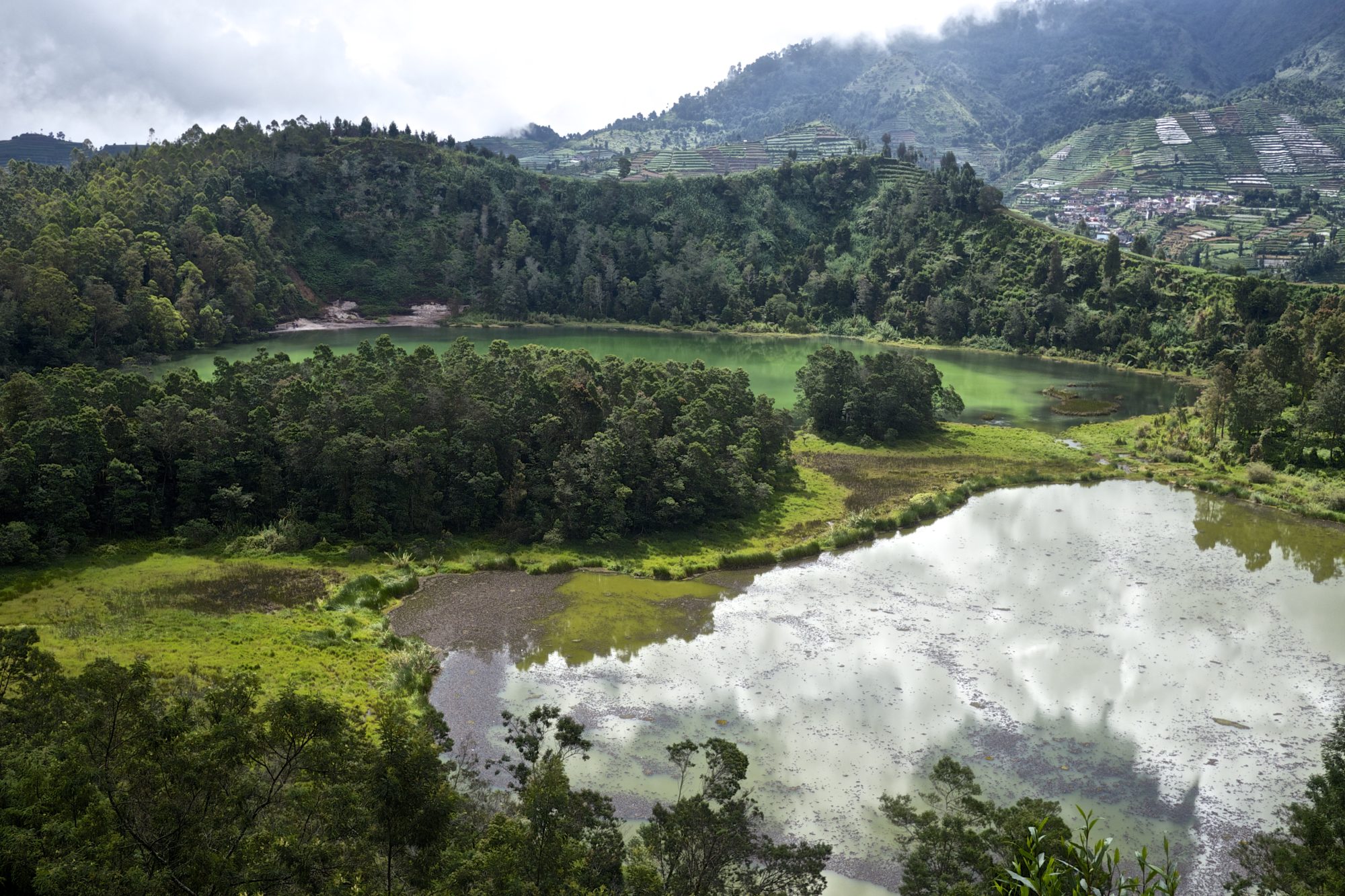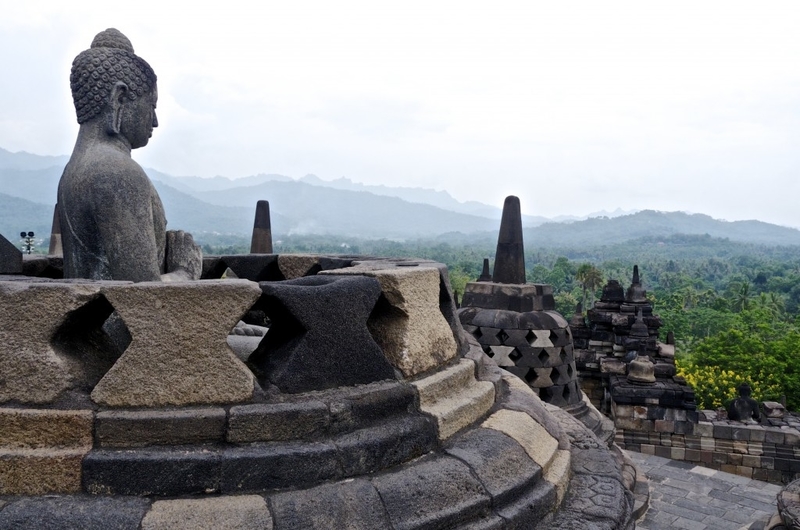
Visiting the Temples of Borobudur and Prambanan
Though Indonesia is the most populous Muslim country on Earth, the archipelago nation has a deeply-rooted, multi-religious history.
It is a place where minarets share space with Buddha-clad temples and richly-decorated Hindu shrines.
Indonesia’s rich religious heritage is particularly apparent in the cultural capital of Yogyakarta (also known as Jogja), where the iconic temples of Borobudur and Prambanan rise from the bottle-green hills of central Java.
THE YOGYAKARTA TEMPLES
Bali may be the land of 1,000 temples, but Yogyakarta is arguably home to Indonesia’s most impressive religious monuments. Dozens of temples litter the Javanese city of Yogyakarta, showcasing the island’s rich heritage.
Today, while almost 100 percent of Java’s population adheres to Islam, the island’s two main religious sites—Borobudur and Pramban—are Buddhist and Hindu respectively.
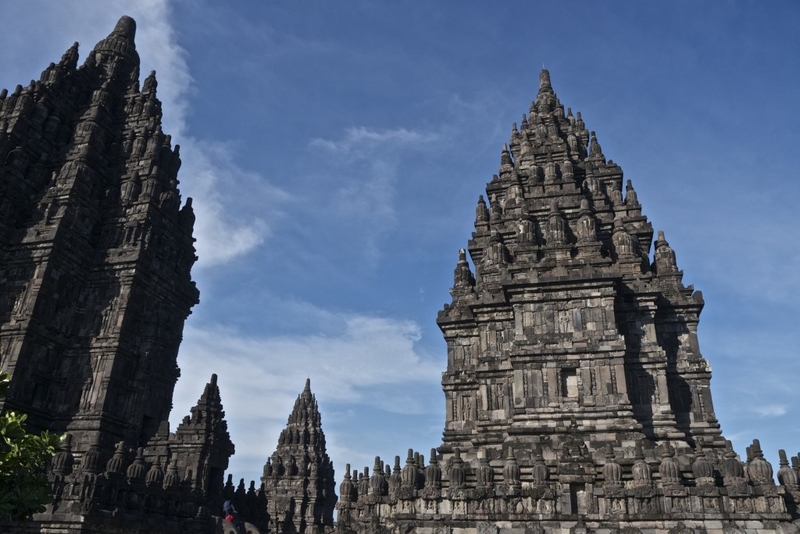
The magnificent Yogyakarta temples lie along a popular Java tourist circuit that includes Mount Bromo and the Kawah Ijen Volcano.
They are among the grandest cultural icons of Southeast Asia.
THE BUDDHIST BOROBUDUR TEMPLE
Borobudur is the world’s largest single Buddhist structure. It is, without a doubt, the #1 thing to see in Yogyakarta.
Together with Angkor Wat in Cambodia, Ayutthaya in Thailand and Bagan in Myanmar, Borobudur is a top bucket list destination for Asian history and archaeology buffs.
The beautiful temple boasts a dramatic backdrop of mist-shrouded volcanoes and mountains. It is impressive in both its grandeur and its detail.
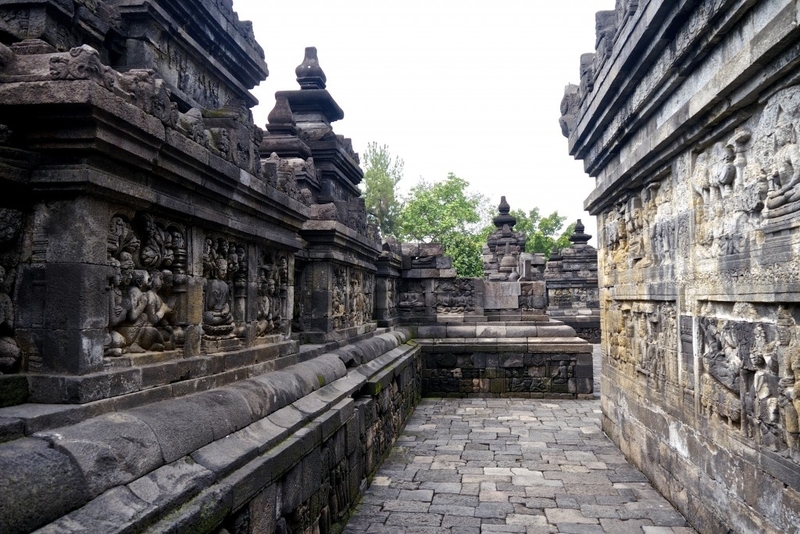
Borobudur dates back to the 9th century’s Sailendra Dynasty. In the 14th century, as the region slowly started to convert to Islam, the temple of Borobudur became abandoned.
VISITING BOROBUDUR FROM BOTTOM TO TOP
The Mahayana Buddhist temple of Borobudur is a giant allegory for enlightenment.
Visits to Borobudur begin at the base of the temple and continue upward, through three levels of Buddhist cosmology.
Reliefs along the temple’s lowest level depict a world driven by passion and desire (Kamadhatu). Layers of narrow corridors take visitors past thousands of decorative panels that contain illustrations of Buddhist doctrines and images of daily Javanese life. As the levels spiral upward, the depictions progress to Rupadhatu (world of forms) and Arupadhatu (world of formlessness).
Buddhist pilgrims starts at the bottom and move upward after deciphering each relief. The interpretations progressively get harder until you reach the top and—in theory—become enlightened.
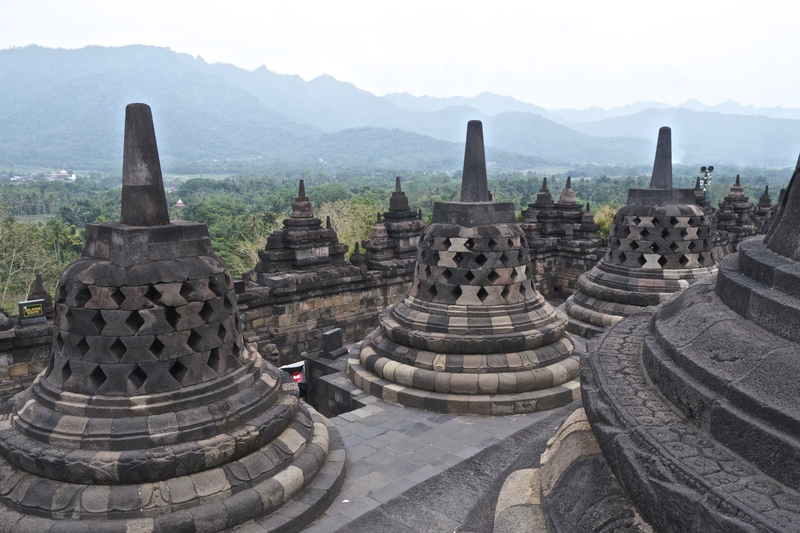
Seventy-two bell-shaped stupas lie at the top of Borobudur, each concealing statues of the Buddha. And in these stupas, each Buddha has a different hand gesture, or mudra. These mudras represent the five compass points in Buddhism–North, South, East, West and Zenith.
Despite its historic and religious importance, Borobudur was only re-discovered in the late 1800s, after laying hidden for centuries under a blanket of tangled vines and volcanic ash.
Today, after a lengthy restoration, it is considered to be one of the greatest temples on Earth.
VISITING BOROBUDUR AT SUNRISE
Like many temples in Southeast Asia, Borobudur is especially popular to visit at sunrise. Loads of travelers descend on the temple at the crack of dawn to watch the emerge from behind the stupas of the world’s largest religious structure.
Vsiting Borobudur at sunrise requires special tickets.
We chose not to visit the temple at sunrise. Though I’m sure that sunrise at Borobudur would have been lovely (albeit crowded), I don’t feel like we particularly missed out.
GETTING TO BOROBUDUR
In Indonesia, Grab is a cheap and easy way of getting around. Like Uber or Lyft, it is an app that matches you with local drivers.
Though I used a regular taxi to go between Yogyakarta and Borobudur, my parents traveled to Indonesia recently and spoke very highly of their experience with the rideshare app.
For adventurous travelers, getting to Borobudur by bus is certainly an option. The Trans Jogja service runs from central Yogyakarta to the Jombor bus terminal in northern Yogyakarta. There, you can change to another bus to get to Borobudur.
If you’re traveling to Borobudur as part of an organized tour, your excursion will likely include roundtrip transport.
VISITING THE HINDU PRAMBANAN TEMPLE
Prambanan is somewhat overshadowed by the more internationally renowned Borobudur, but the temple is equally impressive.
Visiting Prambanan is one of the top things to do in Yogyakarta. As the temple only takes a couple hours to see in its entirety, it can easily be bundled into a day trip alongside Borobudur.
Prambanan is primarily Hindu, yet the area consists of over 500 temples that are both Hindu and Buddhist in origin and design.
Thus, Prambanan and its surrounding temples are not only valuable architectural and cultural relics, but also standing proof of past religious cohabitation on Java.
PRAMBANAN TEMPLES
Prambanan’s main temple, Candi Shiva Mahadeva, rises 47 meters above its surroundings. The vibrant reliefs carved onto the inner wall of the gallery illustrate scenes from the Ramayana—a 24,000 verse Hindu epic that recounts the life of Lord Rama and his wife, Sita.
Flanking Candi Shiva’s tower are two slightly smaller temples dedicated to Brahma and Vishnu respectively.
After admiring Candi Shiva , we strayed from the crowds and ventured toward the smaller temples in and around Prambanan—Candi Lumbung, Candi Bubrah and Candi Sewu.
Though the former two lie largely under scaffolding and resemble little more than rock piles, the latter is remarkably well-preserved.
CANDI SEWU NEAR PRAMBANAN
Candi Sewu is the largest and most impressive of the temples surrounding Prambanan. Though it lies merely half a mile from the main Hindu temple complex, Candi Sewu is actually a Buddhist relic. It is the second largest Buddhist temple in Indonesia, after Borobudur.
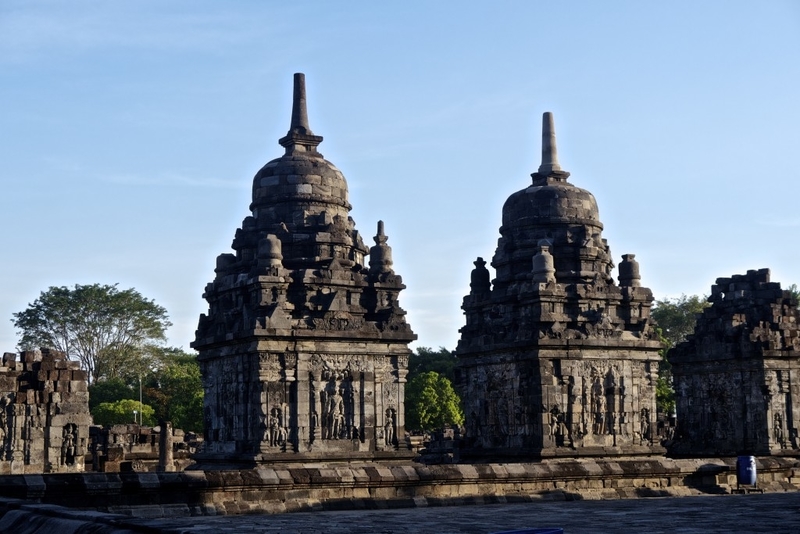
The eighth century Mahayana Buddhist relic
GETTING TO PRAMBANAN
Prambanan lies just 17km east of Yogyakarta and is easily accessible by public bus. You can take the Trans Jogja bus route 1A to Prambanan temple. It connects the airport with the temples, passing by downtown along the way.
We chose to take a taxi to Prambanan for the purpose of convenience. Grab (similar to Uber) is also a convenient travel option that is ideal for people with Indonesian SIM cards or international data plans.
Alternatively, you can visit Prambanan as part of a tour. Most Prambanan tours include transport to and from Yogyakarta.
PRAMBANAN AND BOROBUDUR: LOGISTICS
WHERE TO STAY IN YOGYAKARTA
I stayed at Bhumi Hostel during my visit to Yogyakarta. As far as hostels go, I found Bhumi to have a wonderful vibe. The staff gave us ample information on Yogyakarta dining, helped us organize a day trip to the Dieng Plateau, and advised us on our onward travels to Bali, Gili Air, and Komodo Island.
Alternatively, the Wonderloft Hostel is another cheap place to stay with great reviews.
If you’re not a hostel person, you’ll find a wide range of other accommodation options in Yogyakarta.
Some of the nicest hotels in Yogyakarta—like the Phoenix Hotel, the Melia Purosani and the Harper Malioboro—are quite inexpensive by international standards and fit most midrange price points.
And if you’re a points collector or you like to stay at internationally-branded hotel chains, you can’t go wrong with Yogyakarta Marriott or Sheraton Mustika Resort.
TOURS OF PRAMBANAN AND BOROBUDUR
Since the Yogyakarta temples are among the top places to see in Indonesia, it comes as no surprise that they’re absolutely packed with tourists.
Local tourists seemed to outnumber international visitors in Yogyakarta. Most tourists consisted of schoolchildren that seemed to find us absolutely fascinating. They were everywhere, taking our photos every which way we turned.
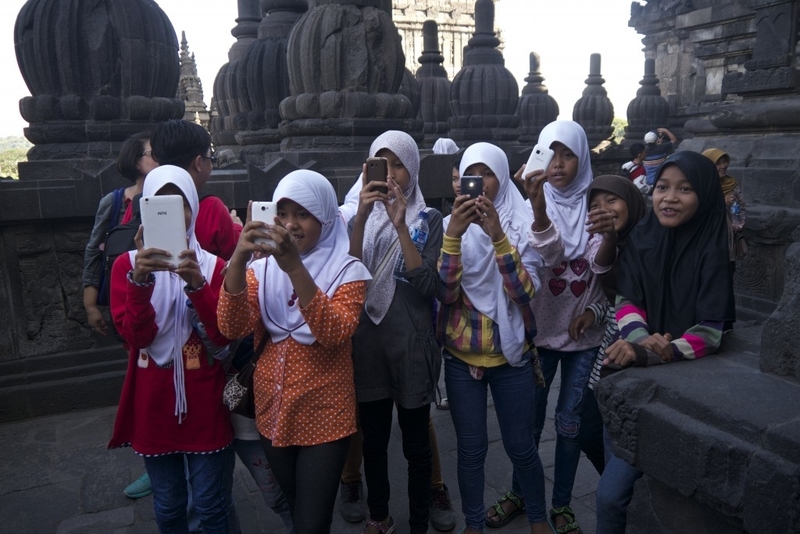
Still, while domestic tourism brought the largest crowds, international travelers were far from an anomaly. Tourism is a huge industry in Yogyakarta and there are plenty of organized tours of the area that cater to English-speaking travelers.
Online, you can find sunrise tours of Borobudur, combination group tours of Borobudur and Prambanan, and private comprehensive tours that include both iconic temples and the Merapi Volcano.
BOROBUDUR AND PRAMBANAN ENTRANCE TICKETS
Entrance tickets cost $25 USD per person for each temple or $45 for a combination ticket. The price is steep by Indonesian standards but, considering the importance of the two Yogyakarta temples, it is no doubt worth paying.
The Borobudur entrance fee does not include visits before sunrise.
An additional fee ($35) grants you access to the temple as the sun emerges from behind the surrounding jungle.
OTHER YOGYAKARTA TEMPLES
Though Borobudur and Prambanan are the undisputed highlights of Yogyakarta, there are certainly other noteworthy temples to visit if you have time in your Indonesia itinerary. Other prominent religious heritage sites include the Ratu Boko Temple, Candi Ijo, and the Mendut Temple.
We did not personally visit Yogyakarta’s smaller temples during our trip to Indonesia.
GETTING TO AND FROM YOGYAKARTA
Yogyakarta is well connected to destinations around Asia. In addition to a handful of Indonesian cities, Yogya’s airport has year-round direct flights to Singapore, Kuala Lumpur and seasonal service to Jeddah and Medina.
As Java’s main tourism hub, Yogyakarta is linked to the rest of the island by train and bus.
From Yogyakarta, we used a combination of buses and ferries to travel onward to Bali, the Gili Islands, and Komodo Island.
WHEN TO VISIT THE PRAMBANAN AND BOROBUDUR TEMPLES
During my visit to Yogyakarta, I experienced both the pros and cons of travel in the high season: good weather, and intense crowds.
The best time to visit Borobudur and Prambanan is during the dry season, from April to October. We visited Indonesia in June and had wonderful weather throughout our entire three week vacation.
Yes, the major tourist sites were crowded.
But we were also able to enjoy ample sunshine, reasonable temperatures, and low humidity.
***
The devastating 2006 earthquake wasn’t the first obstacle threatening the temples of Yogyakarta. Nor will it likely be the last.
To date, the archeological sites have survived a 1985 bombing, vandalism and volcanic eruptions.
On an island that is susceptible to natural disasters, the survival of both Borobudur and Prambanan will take continued effort.
And yet, despite centuries of obstacles thrown their way, the iconic Yogyakarta temples still rise enigmatically from the surrounding jungle—dazzling visitors with their grandeur and standing as a testament to Java’s deep-rooted multi-religious past.
______________________________________
DID YOU ENJOY THIS GUIDE TO BOROBUDUR AND PRAMBANAN? PIN IT!

